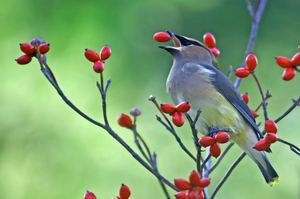A SHORT GUIDE FOR ATTRACTING BIRDS AND POLLINATORS INTO YOUR GARDEN
Nearly one-third of North Americas bird species are in serious decline and the primary reason is habitat loss. As more and more land gets developed, its important to create these biological corridors that connect isolated fragments of nature, building them out of native plants that support the food web, creating a balanced ecological community.
Simple shrubs or thickets tightly grouped emulate plant hedges or hedgerows for bird cover. Mix several shrub species if there is enough planting area, offering a greater selection of nest sites.
Select plant material that offer fruit/seeds at different seasons that provide a varying food supply throughout the year, especially in winter, when other forms of food is sparse.
Varying vegetation levels is important. Vertical layers naturally occur at woodland edges. Plant small trees, shrubs, vines, perennials, ground covers. Some bird species sing and feed in a canopy, others at lower levels.
Multi-layered, bright colored, tubular flowers (Trumpet vine, columbine, bee balm, bugleweed, etc) are the secret to attracting hummingbirds. In a New York City backyard garden the Ruby-throated hummingbird is the most common hummingbird visitor.
Birds enjoy having water available to them, but standing water is also the breeding ground for mosquitoes in Manhattan gardens. A recommendation might be to have a couple of boulders that have a concave surface where shallow water can collect after precipitation for several hours to at most, a couple of days.
If you have a lawn,.. do not consider it a wildlife magnet. Turf grass is a monoculture that provides little benefit to an ecosystem. Consider minimizing it or adding a variety of ground-covers.
If you vary the menu offered, you vary the attraction of the meal to the bird population. This applies to a small backyard garden design or a suburban residential garden design. Variety is truly the spice of life. Goldfinches and Chickadees (and other seed eating birds) feed on the mature seeds of coneflowers, Juncos feast on asters, switchgrass attracts thrushes and sparrows, dogwood fruits are eaten by Thrashers, Waxwings, Woodpeckers, Cardinals, et cetera.
Rather than purchasing mulch to topcoat in fall, leave leaf litter within your planting beds (in your yard) for the food, water and shelter it can provide overwintering birds. Consider that it also breaks down and eventually becomes compost.
If you have the opportunity to plant a tree, try a native Serviceberry (Amelanchier sp). Mulberries are great for birds, but they produce a mess of fruit.. and become a maintenance issue.
Limited for space and can’t put in a huge shrub in your townhouse garden or Brooklyn backyard? Put in a small Mapleleaf Viburnum as a compliment to other shrubs or small trees. It’s low growing, very shade tolerant and has somewhat open growth, maturingxz at 3-4’. The berries are readily consumed, and the foliage) which turns a stunningly beautiful plum-red color in fall) could be a nesting site for Northern Cardinals or Grey Catbirds.
A bird feeder is a great enticer for birds and can be tastefully incorporated into a Brooklyn garden design. With climate change and overdevelopment it has become more difficult for our feathered friends. Planting native plants rather than exotics is a great beginning.




